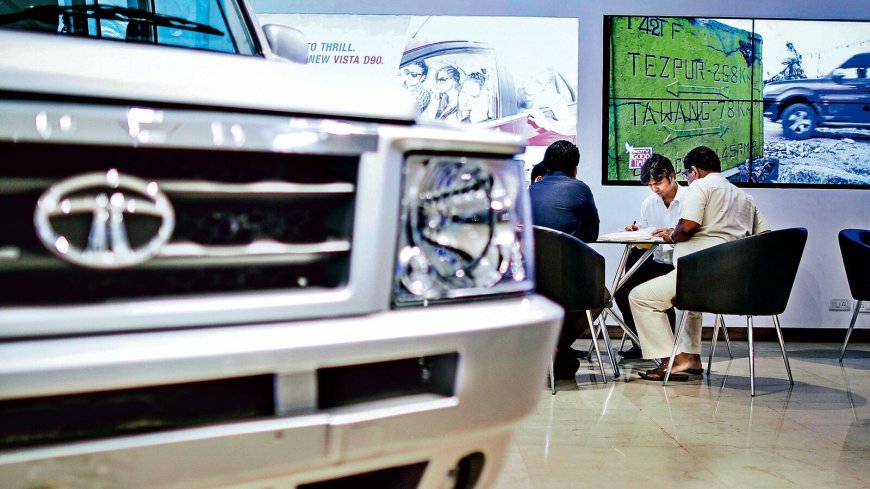Tata Motors April 2025 Sales Decline by 6%; EV Volumes Drop 16% YoY
Tata Motors reports a 6% decline in April 2025 sales to 72,753 units, with electric vehicle volumes plunging 16% year-on-year. Explore detailed segment-wise analysis and market implications.

Tata Motors Sales Slide 6% in April 2025 to 72,753 Units; Electric Vehicle Sales Drop 16% YoY
India’s automotive giant Tata Motors Ltd began FY26 on a cautious note, reporting a 6% year-on-year (YoY) decline in total vehicle sales for April 2025. The company dispatched 72,753 units during the month compared to 77,521 units in April 2024. While commercial vehicles (CVs) and passenger vehicles (PVs) both saw contractions, the Electric Vehicle (EV) segment took a sharper hit, slumping 16% YoY.
This sales update comes at a time when macroeconomic concerns, seasonal demand normalization, and tightening competition in the EV space have started shaping buying patterns and strategic recalibrations across the sector.
🔍 At a Glance: Tata Motors April 2025 Sales Snapshot
| Segment | April 2025 | April 2024 | YoY Change |
|---|---|---|---|
| Total Sales | 72,753 | 77,521 | -6% |
| Passenger Vehicles (PV) | 45,532 | 47,007 | -3% |
| Electric Vehicles (EVs) | 5,318 | 6,516 | -16% |
| Commercial Vehicles (CV) | 27,221 | 30,514 | -11% |
🚘 Passenger Vehicles: Mixed Bag with Subdued Growth
Tata Motors sold 45,532 passenger vehicles (including EVs) in April 2025, registering a marginal 3% YoY drop. Domestic PV sales stood at 45,199 units, down from 47,107 units last year. Export numbers, however, grew from 100 to 333 units, showing international traction despite local softness.
📉 What’s Driving PV Weakness?
-
Post-festive season demand dip
-
Inventory correction by dealers
-
New model launches by competitors (notably in the compact SUV and hatchback space)
-
Moderate consumer sentiment in entry and mid-level vehicle segments
Despite the dip, Tata's flagship ICE models like Nexon, Punch, and Altroz continued to perform steadily, although some cannibalization from sibling EV models was observed.
⚡ EV Volumes Take a Bigger Hit: Down 16% YoY
The biggest headline is the EV sales volume, which dropped to 5,318 units in April 2025 from 6,516 units in April 2024 — a 16% fall.
🔎 What Went Wrong in EV Sales?
-
High base effect from April 2024
-
Increased competition from MG, Mahindra, Hyundai, and newer budget-friendly players
-
Consumers waiting for updated 2025 versions of Nexon EV and Tiago EV
-
Slower uptake in fleet segment due to financing and subsidy issues
However, there was a sequential improvement over March 2025 (4,710 units), hinting that EV demand could rebound as newer models and updated pricing roll out in Q2 FY26.
🚛 Commercial Vehicle Segment Faces Double-Digit Decline
Commercial Vehicles (CVs), traditionally a strong pillar for Tata Motors, witnessed a sharp 11% YoY decline, with 27,221 units sold in April 2025 compared to 30,514 units in April 2024.
Segment-Wise Highlights:
-
Medium and Heavy CVs (M&HCV): Down 7%
-
Intermediate and Light CVs (ILCV): Down 10%
-
Small CVs & Pickups: Dropped by a massive 23%
-
Exports: Rose to 1,457 units, up 43% YoY, offering some cushion
📉 Reasons for CV Slowdown:
-
Lower construction activity due to elections and paused infrastructure rollout
-
Delayed freight demand rebound post-monsoon
-
Financing headwinds in SME truck operators
-
BS6-compliant vehicle price inflation dampening replacement purchases
🧠 Management Commentary
A Tata Motors spokesperson commented:
“While the YoY decline in volumes reflects a high base and seasonal transition, we are seeing encouraging signs of recovery in select sub-segments. With new launches, a focus on EV innovation, and a robust pipeline, we remain confident of stronger performance in the coming quarters.”
📊 Stock Market Reaction
Following the sales data release, Tata Motors stock showed minor intraday pressure but held steady overall. Analysts had largely priced in a soft start to FY26.
NSE closing on April 30, 2025: ₹894.20
1-month performance: +2.1%
YTD gain: +11.3%
Market participants are watching the EV trajectory closely, especially as Tata gears up for next-gen EVs with larger range, better pricing, and upgraded tech.
📦 Tata Motors vs. Competition – EV Sales (April 2025)
| Company | EV Sales | YoY Change |
|---|---|---|
| Tata Motors | 5,318 | -16% |
| MG Motor | 1,820 | +12% |
| Mahindra | 1,450 | +10% |
| Hyundai | 1,150 | +25% |
Tata continues to lead the Indian EV market by volume, but its dominance is thinning as more players enter and invest aggressively in battery tech, range, and urban mobility solutions.
🏁 What to Expect Going Forward
🔄 Recovery Levers for Tata Motors:
-
Facelift Launches – Nexon and Altroz upgrades expected by Q2 FY26
-
New EV Models – Curvv EV and Sierra EV expected to debut by Q3
-
Commercial Vehicle Cyclical Pickup – Infrastructure push post elections
-
Export Strategy Expansion – Focus on Latin America, Middle East, and Africa
-
EV Financing Innovation – Tata Capital’s subsidized EV loans may drive volume
📌 Key Risks
-
Commodity inflation affecting input costs
-
Regulatory changes in EV subsidies
-
Increased discounting by rivals in entry-level ICE and EV segments
-
Financing constraints in commercial buyer segments
💡 Analyst Insight
Motilal Oswal Auto Desk noted:
“While the April dip may seem alarming, it’s more of a cyclical speed bump than a structural decline. Tata Motors has the innovation pipeline, scale, and financial backing to stay ahead of the curve in India’s electrification journey.”
Jefferies India added:
“The EV market is fragmenting quickly. Tata needs to innovate faster and expand portfolio diversity to protect market share.”
April 2025 has been a mixed bag for Tata Motors. A 6% drop in overall sales and 16% fall in EV volumes indicate short-term softness, but not a long-term derailment. The company continues to lead in electrification, remains a commercial vehicle heavyweight, and is proactively addressing demand gaps.
While challenges persist, Tata Motors' robust fundamentals, product innovation, and brand trust will likely steer it toward a stronger Q2 and beyond.
📉 Short-term pain, long-term conviction — that seems to be the story of Tata Motors this quarter.
What's Your Reaction?
 Like
0
Like
0
 Dislike
0
Dislike
0
 Love
0
Love
0
 Funny
0
Funny
0
 Angry
0
Angry
0
 Sad
0
Sad
0
 Wow
0
Wow
0












































































